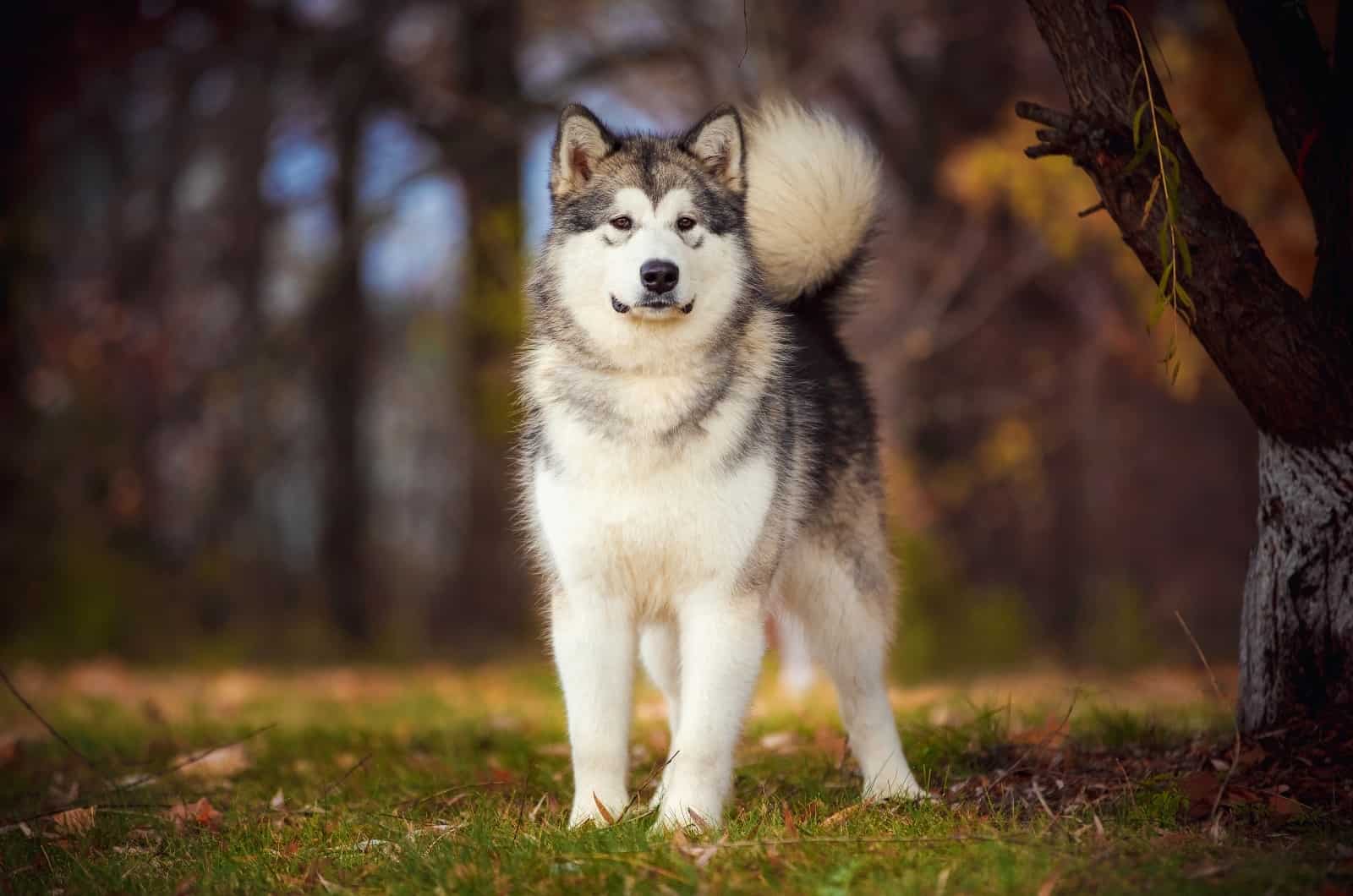The Alaskan Malamute feeding chart is one of the best tools for every dog owner, especially for those who don’t have prior experience with this type of canine.
In order to keep your canine’s weight under control, it should get only high-quality food.
Dietary supplements are a great addition to dog meals, but only if the meal itself is suitable for your Alaskan Malamute.
Your dog’s health and weight depend heavily on the type of food it ingests.
Read on to find out what the best way is to keep your pup fit and healthy!
Alaskan Malamute Feeding Chart
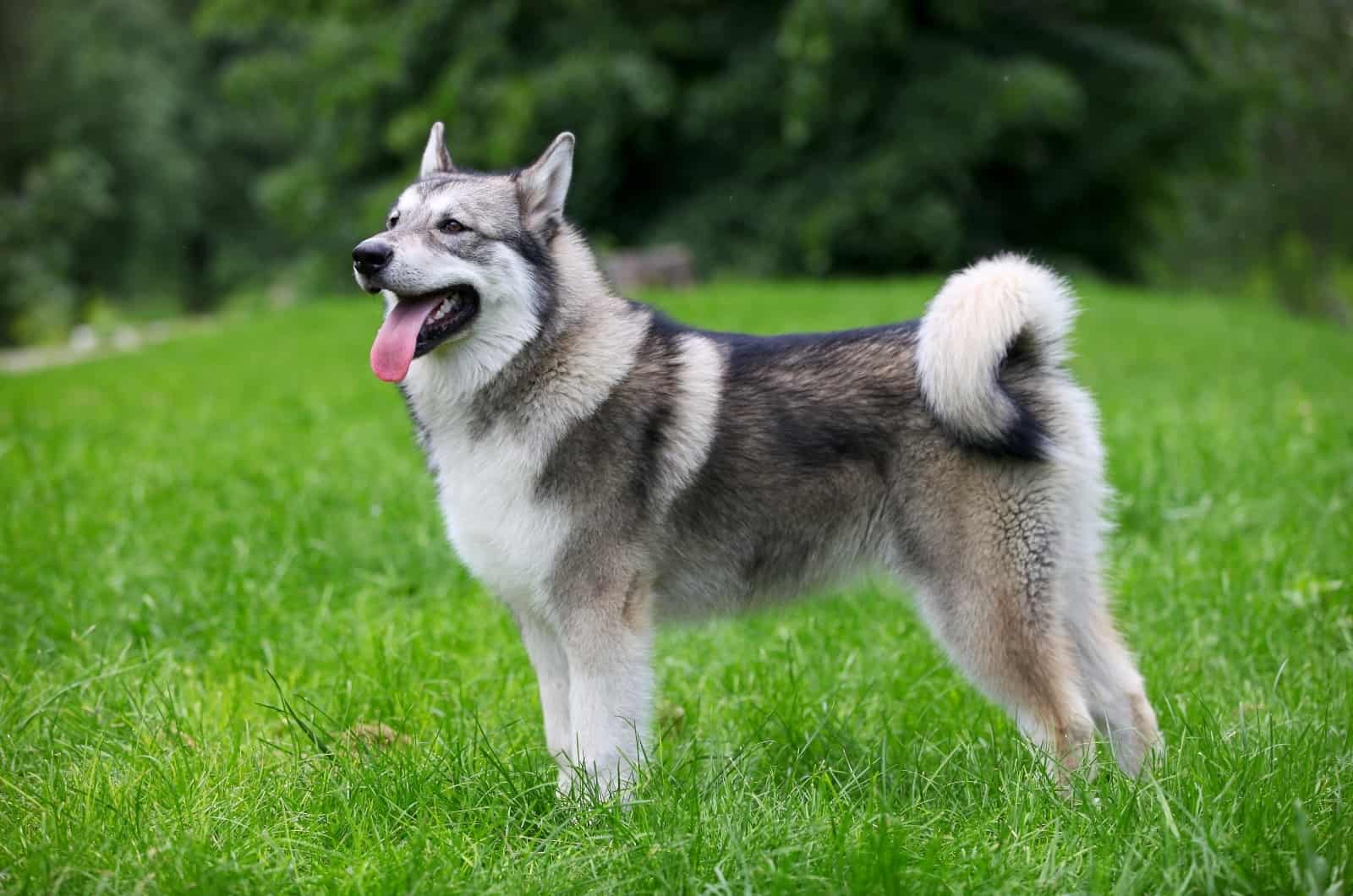
You need to do thorough research on this canine breed before you bring a Malamute into your house, and the question of what kind of food is good for them is one of the most crucial ones.
Malamutes are known as big canines that could probably eat a horse, considering how big their appetite is.
They aren’t picky eaters, and won’t have issues eating anything edible that they come across; however, this type of appetite leads to weight gain, and it might put their wellbeing in jeopardy.
To make sure that your pup is within the parameters of healthy weight, you should pay attention to its current weight, and whether it is within the general guidelines for this dog breed.
The best way to do this is by comparing your pup’s weight with the Alaskan Malamute weight chart:
[table id=744 /]
Alaskan Malamute Puppy Feeding Chart
Alaskan Malamutes are big canines… there’s no doubt about that, which is why their puppy weight during the first months of life might be the adult weight of some smaller canine breeds.
Large dog breeds, such as the Alaskan Malamute, have different feeding needs that are based on their growth rate.
In order to fully understand the development process of Alaskan Malamutes, it is important to describe their growth during the first year of life in detail.
First Two Months
Mother’s milk is one of the most important sources of nutrients during the first month of the Alaskan Malamute puppy’s life.
This type of food contains enough calories and supplements for the puppies to survive, which is why it’s crucial not to wean them off before they turn at least three weeks of age.
The weaning process shouldn’t be abrupt. If you notice that the mother is irritated and constantly trying to get away from her pups, you can help her with weaning by taking her away from the puppies for an hour at least once or twice a day.
This time can be used for the introduction of puppy food. You can mix it with puppy formula (especially if you go with kibbles) or gradually increase the number of meals that don’t include mother’s milk.
Keep in mind that these are still not considered full meals, so make sure that your pup gets enough nutrients throughout the day.
Three to Ten Months
This might seem like a large period, especially since Alaskan Malamutes will go through major changes during this time, but in terms of meals, you should stick to almost the same feeding schedule throughout.
Puppies of the Alaskan Malamute breed should have four smaller meals each day, with four- to five-hour breaks in between each one.
The precise times of each feeding can be changed to accommodate your schedule, but you should try to maintain some sort of consistency wherever it is allowed.
The balance between the amount of food that your pup receives during every mealtime is one of the most important things during this period.
It is better to keep the portions smaller to prevent overfeeding. Alaskan Malamutes, especially puppies, don’t really know when to stop, so if you feed them larger portions fewer times a day, they will get used to eating everything in the bowl as soon as you bring food.
Ten To Twelve Months
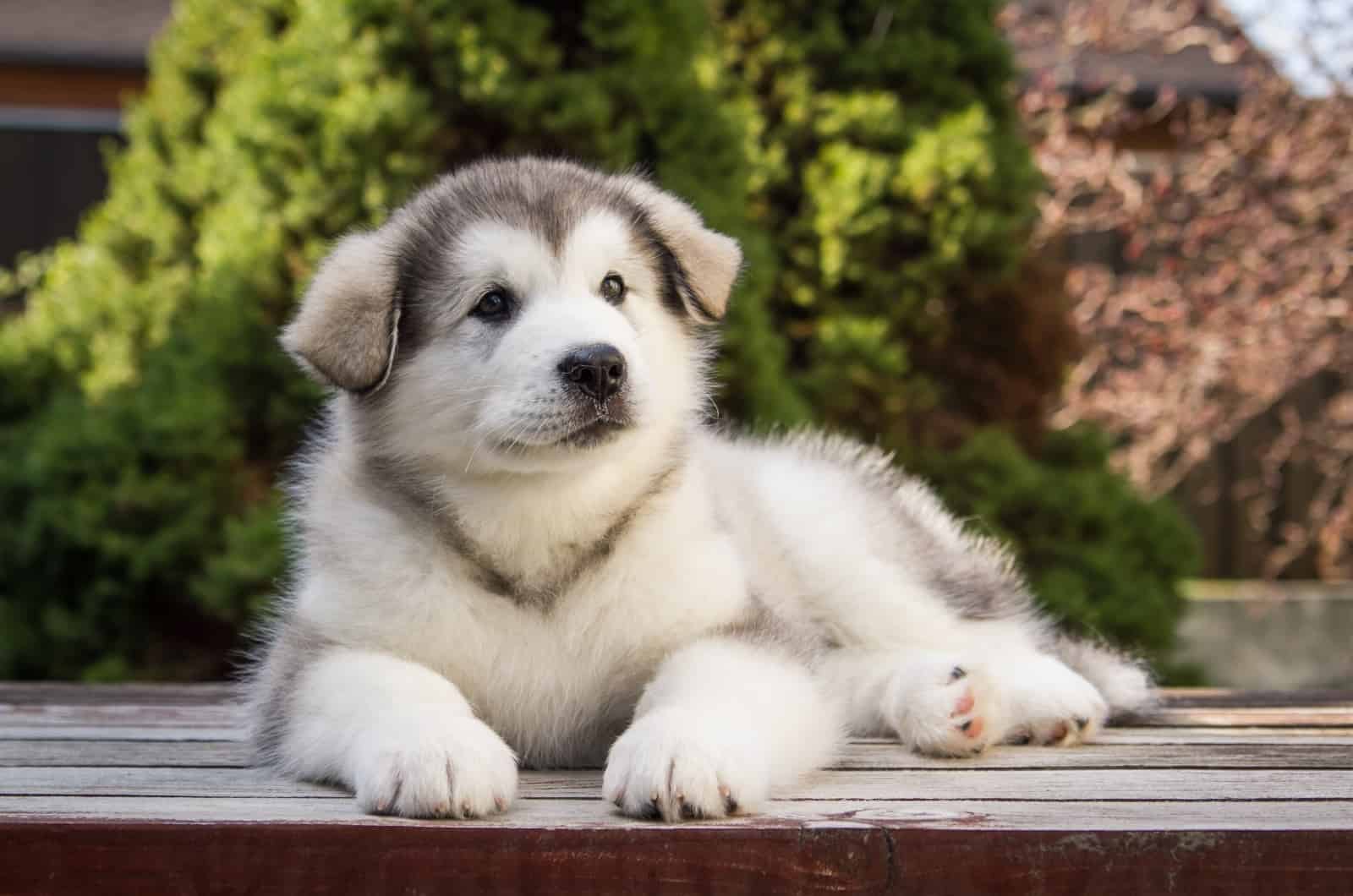
Although Alaskan Malamutes are generally still considered puppies during this period, I’d rather call them adolescents, especially since they behave that way.
However, in terms of feeding, this is the right time to start with the change of dog food.
Alaskan Malamute pooches are usually fed puppy food during the first months of their life. However, once they turn ten or eleven months of age, you can slowly switch from puppy to adult dog food.
The best way to do this is by mixing adult food with the ones for puppies. You can start by adding one-third of adult food into their regular meals.
After a week, you can increase the amount to 50%, and if the pup accepts it without any problems, you can add more adult food until the final switch is made.
Try to keep puppy food in their meals until Alaskan Malamutes turn one. After that, you can completely switch to adult food.
By using this method, your canine will easily adjust to the transition.
Adulthood
After the first year of life, Alaskan Malamutes can transfer completely from puppy food to adult food. Their feeding schedule will change as well, as the general recommendation for these canines is to have two feedings during the day at most.
The time intervals for feedings depend on you and the schedule that you make. It would be best to keep the feedings between seven and eight hours, but everything up to 12 hours is considered tolerable.
Another thing that is important to mention is the free-feeding method that is sometimes used for feeding certain dog breeds.
However, this method is not applicable to Alaskan Malamutes, as these canines love food so much that they can’t stop eating until the bowl is empty.
This can be a great issue as it might cause overeating, which could result in health issues such as obesity, bloating, or even more serious stomach problems.
Why Can’t Adult Alaskan Malamutes Eat Puppy Food?
Puppy food is a great source of nutrition for Alaskan Malamute puppies; however, adult dogs require a different type of diet in order to get all the nutrients.
Food for puppies contains a high percentage of calories, which benefits pups during their growth. But, if adult canines continue eating this type of food, they might easily become obese, as they won’t have the chance to spend all the excess calories.
Proteins, vitamins, and minerals are some of the main ingredients of food for adults, which helps maintain the healthy balance of the dog’s weight. It also keeps their bones and muscles strong and well-developed.
Of course, if you have a bag of puppy food that you don’t know what to do with after the transition, you can keep adding it to dog meals until it’s empty.
But, feeding a mature canine puppy food won’t bring any good in the long term.
What Type Of Food Is Good For Alaskan Malamutes?
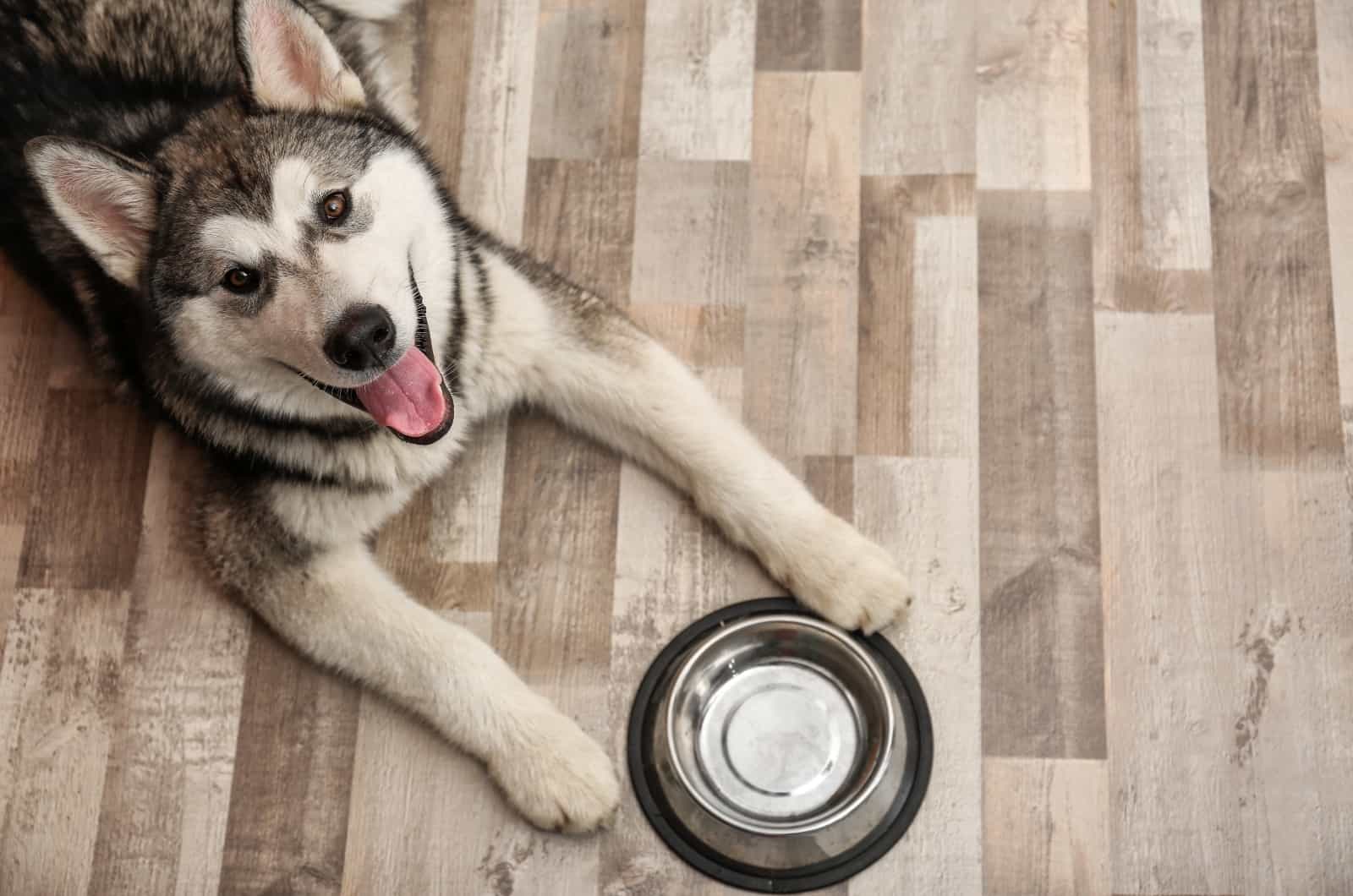
Large canine breeds, such as Alaskan Malamutes, are prone to obesity, which is why their diet should consist more of high-quality ingredients such as proteins, ground bones, healthy fats, and veggies rather than carbohydrates.
READ NEXT: 19 Big Guard Dogs: Choose Your Favorite Protector
The quality of dog food is just as important as the quantity.
There are certain foods that are safe for both humans and their canine pets. Some of the best foods for your pet are:
• Bone broth – This is one of the ingredients that contains magnesium, phosphorus, calcium, and other essential minerals that are important for the development of your pet. These minerals have a positive impact on the nervous and cardiovascular systems, muscles, sleep, etc.
• Blueberries – These are considered superfood for dogs for a reason, as blueberries contain antioxidants, vitamins, and fiber. Another great thing about these fruits is that they don’t contain a high percentage of calories, which is why blueberries can be used as dog treats, too.
• Sweet potatoes – Added to a meal or given separately as a treat, this type of food is considered a great option for Alaskan Malamutes, as it contains vitamins, fiber, and beta-carotene, which transforms into vitamin A once digested.
• Carrots – This is another excellent low-calorie treat suitable even for dogs that are on a grain-free diet. Besides being a great source of fiber and vitamins, carrots are also beneficial for the dental health of your pet.
• Eggs – A great number of people will think of proteins as soon as someone mentions eggs. However, this type of food is also rich in healthy fats and vitamins.
• Fish – Salmon, sardines, and anchovies are excellent sources of omega-3 fatty acids that are essential for dogs’ health. If you’re not able to get fish for your pup, fish oil can also be a great replacement.
• Plain yogurt – This food is rich in proteins and calcium, but most importantly, it can function as a probiotic, which is crucial for a dog’s digestive system. If your pup isn’t lactose intolerant, you can add plain yogurt to your dog’s diet several times a week.
• Chia seeds – Because they contain a high concentration of dietary fiber, this type of food can be of great help in the regulation of the pet’s gastrointestinal tract, and might even prevent constipation. Additionally, the fiber included in chia seeds can maintain normal blood sugar levels in your pooch.
• Chicken – This is one of the most popular animal proteins that is often used in kibbles and wet food, but also home-cooked meals. Feeding your canine chicken is an inexpensive way to provide it with a high amount of protein.
• Peanut butter – This is a balanced dog snack in terms of its nutritional value since it not only contains proteins and good fats, but also other nutrient-rich supplements and fiber. It is a rich source of magnesium, as well as folic acid, which promotes the creation of new cells
• Cottage cheese – This type of fermented cheese is a good dog snack for Alaskan Malamutes because it’s rich in nutrients such as magnesium, calcium, proteins, and vitamins. It’s one of the rare dairy products that won’t cause any problems to a dog’s stomach, so you don’t have to worry about its digestive system.
• Pumpkin – This is a type of healthy food that contains natural fiber. This type of veggie can have a positive impact on the canine’s digestive system by preventing diarrhea and constipation, and also relieving an upset belly.
RELATED: My Dog Has Diarrhea, But Is Acting Fine: 10 Common Reasons
Which Food Should You Avoid?
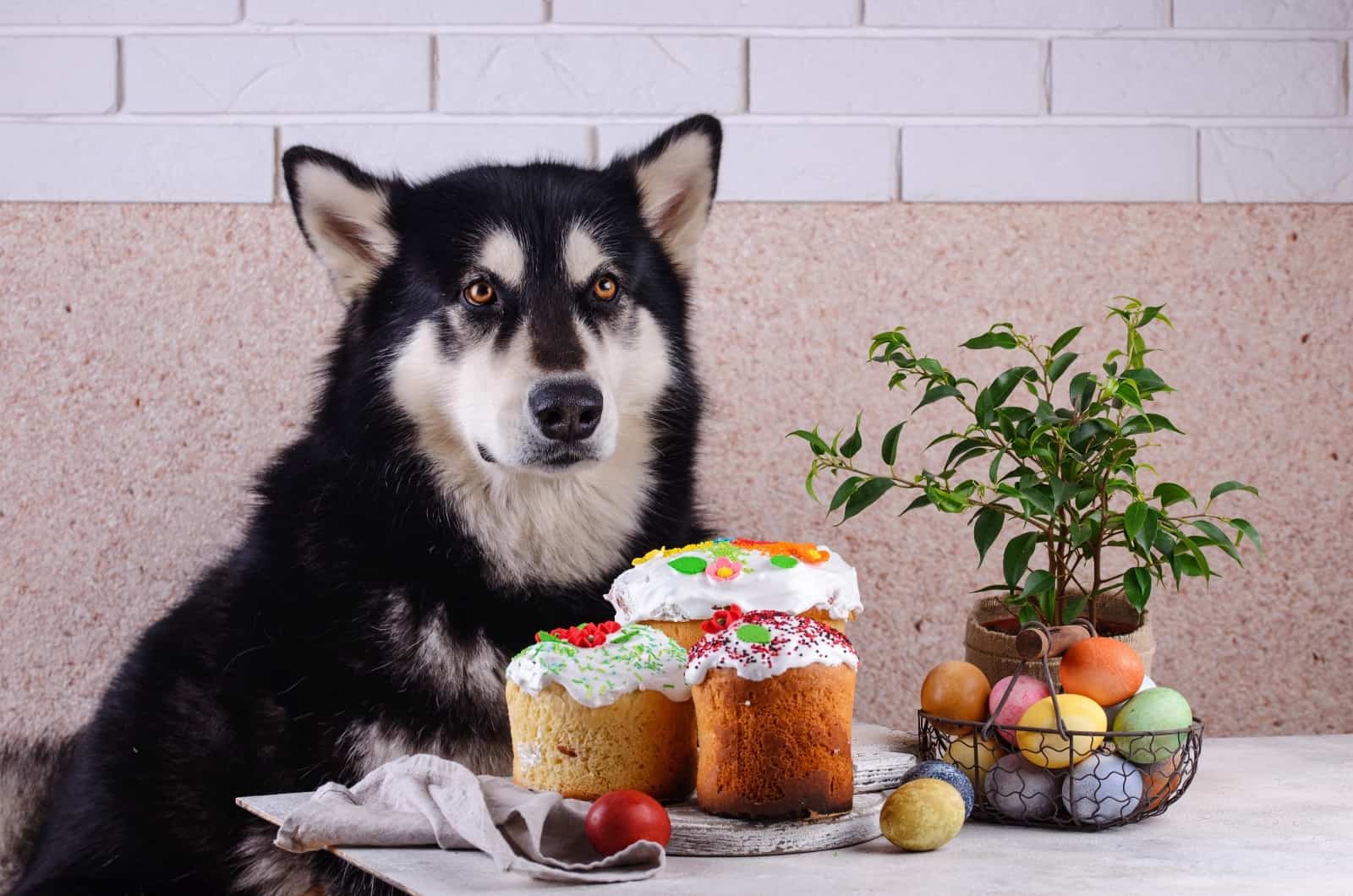
There might be certain human foods suitable for dogs, but the list of foods that should be avoided is far greater.
Therefore, even if your Alaskan Malamute makes an adorable puppy face (which I’m sure they will), you shouldn’t give in and share your meal with it.
However, the point of not sharing the food isn’t related only to digestive issues, food allergies, and dog health in general. If you let your pup get everything it wants, eventually the Alaskan Malamute will turn into the alpha of your family.
That is why it’s important for you as the owner to show dominance, and let them know that you are the leader of the “pack” (household).
Generally, the majority of human food is processed, and contains a high percentage of salt, which can have a negative impact on a canine’s weight and health.
Here are some foods that can be often found in our house that can be detrimental to canine health:
• Alcohol – Essentially, alcohol is toxic even for the human body, let alone for dogs. It can cause poisoning, followed by vomiting, loss of balance, abnormal changes in body temperature, breathing issues, low blood sugar, and even sudden death.
• Raisins – Although considered healthy for humans, raisins can cause major issues in dogs, and might lead to kidney failure. What is more surprising is the fact that even one raisin can cause serious health problems for pooches.
• Caffeine – One of the most popular human drinks, coffee, leads to serious heart arrhythmias, in addition to raising the heart rate, which is why it should be avoided. It’s also possible for animals to experience convulsions, seizures, and loss of muscle strength. Caffeine has an effect on the digestive system, and can cause nausea, puking, and diarrhea.
• Onions and garlic – This food might have lots of health benefits for people, but that certainly isn’t the case with our furry pets. Actually, it has been proven that this ingredient can cause anemia in canines, which can lead to other serious health problems.
• Grapes – This fruit causes the same health issues as raisins, which is why it’s crucial to prevent your pup from eating them. Make sure that grapes are always out of the pet’s reach to avoid any unwanted consequences.
• Cooked bones – Some people might be confused by this information, but cooked bones actually aren’t good for your canine. They split into fragments that can cause major harm to the pet’s jaws, throat, and stomach, which can result in death by choking. Boiling can also cause the bone to lose the majority of its nutrients.
• Chocolate – One of the most delicious human sweets contains theobromine – a chemical that has a similar effect as caffeine, so you already can guess why it’s not recommended for canines. Also, chocolate contains sugar, which is a big no-no for pups.
• Candies – Diarrhea, bloating, pancreatitis… these are just some of the issues that might appear if your furry companion ingests candies. One candy might not cause such serious issues, but there’s no reason to take any risks.
• Macadamia nuts – Peanut butter might be a good occasional snack, but that doesn’t apply to macadamia nuts. This type of food can cause loss of muscle strength, vomiting, and hyperthermia.
• Dairy products – Non-fermented dairy products can cause digestive issues in canines, as well as certain allergies, especially if your Alaskan Malamute is lactose-intolerant.
Is A Raw Diet Good For Alaskan Malamutes?
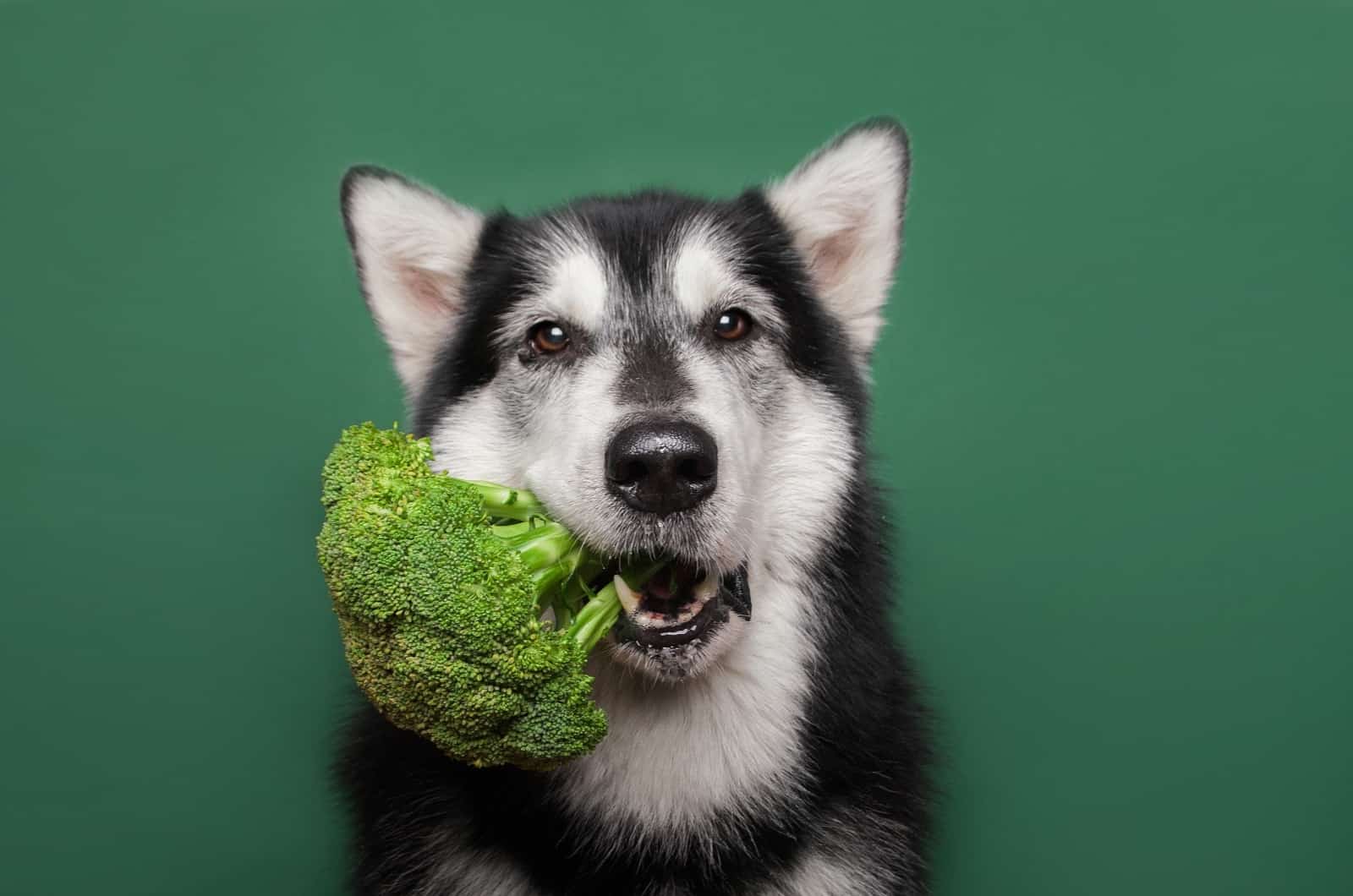
A raw food diet is generally considered a good choice for canines, as it helps dogs maintain a healthy weight and receive good quality food with high nutritional value.
Raw dog food has been a popular choice for sled dogs and canine racers, which is why there are still many supporters of this type of dog feeding.
It is believed that raw ingredients contain a high amount of nourishing elements that can boost the immune system and strengthen the dog’s bones and muscles.
Also, the fat from raw food can make the Alaskan Malamute’s fur shinier, and improve the health of its skin in general.
Some of the most common ingredients that can be found in a raw diet are raw meat, including organ meats, bones, veggies, and fruits, and even eggs.
What Are The Drawbacks of a Raw Diet?
Although raw food has certain health benefits for Alaskan Malamutes, we shouldn’t forget about the disadvantages either.
One of the major drawbacks of introducing such a diet to your pet is the presence of bacteria in raw food, especially in foods such as meat (raw beef, chicken, etc.).
Raw diet also promotes bones as a part of a healthy meal, which is true in terms of the nutritional values that bones possess. However, bones can represent a serious choking hazard, especially fragments, which might cause internal injuries.
Many people argue that this type of diet is rather expensive, and not for everyone’s budget, as raw meat can cost more than five dollars per day, while the majority of daily portions of dog food don’t cost more than two dollars.
If you’d like to try feeding your canine raw food, there’s no reason not to, but make sure that your pup isn’t allergic to any of the ingredients.
RELATED: How Much Raw Food To Feed A Puppy — Everything You Need to Know
How Often Should Alaskan Malamutes Eat Snacks?
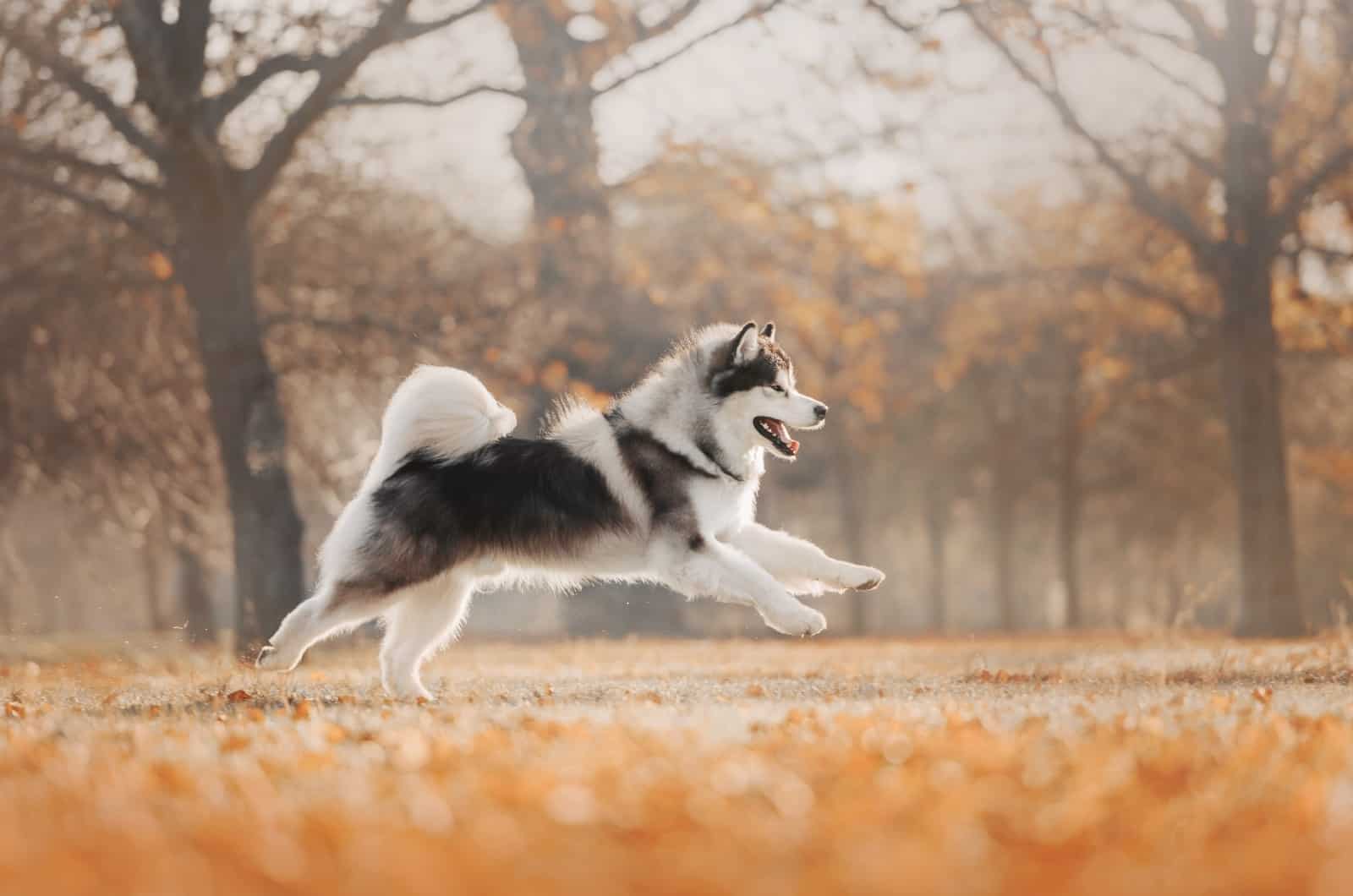
Snacks and treats are the favorite rewards of Alaskan Malamutes. If you have a good boy at home, why not feed him a delicious treat?
Food is one of the main motivations for these canines, and a little number of tasty rewards will go a long way toward making them more responsive to your commands.
Due to the fact that it has already been established that Malamutes and human food do not get along well, the snacks that you offer them should preferably be designed for canines.
Because treats typically have a higher calorie amount than dog food, it is imperative that you always follow the portion amount that is advised on the package to avoid overfeeding your pet.
Treats shouldn’t be given without a reason. As you already know, your pet isn’t hungry, so there’s no reason to give it a snack just because it wants it. Look at treats as rewards for good behavior and obedience.
This way, you will prevent the dominant behavior of your pup, and teach him that the only way to get a snack is to be a good boy.
Final Thoughts
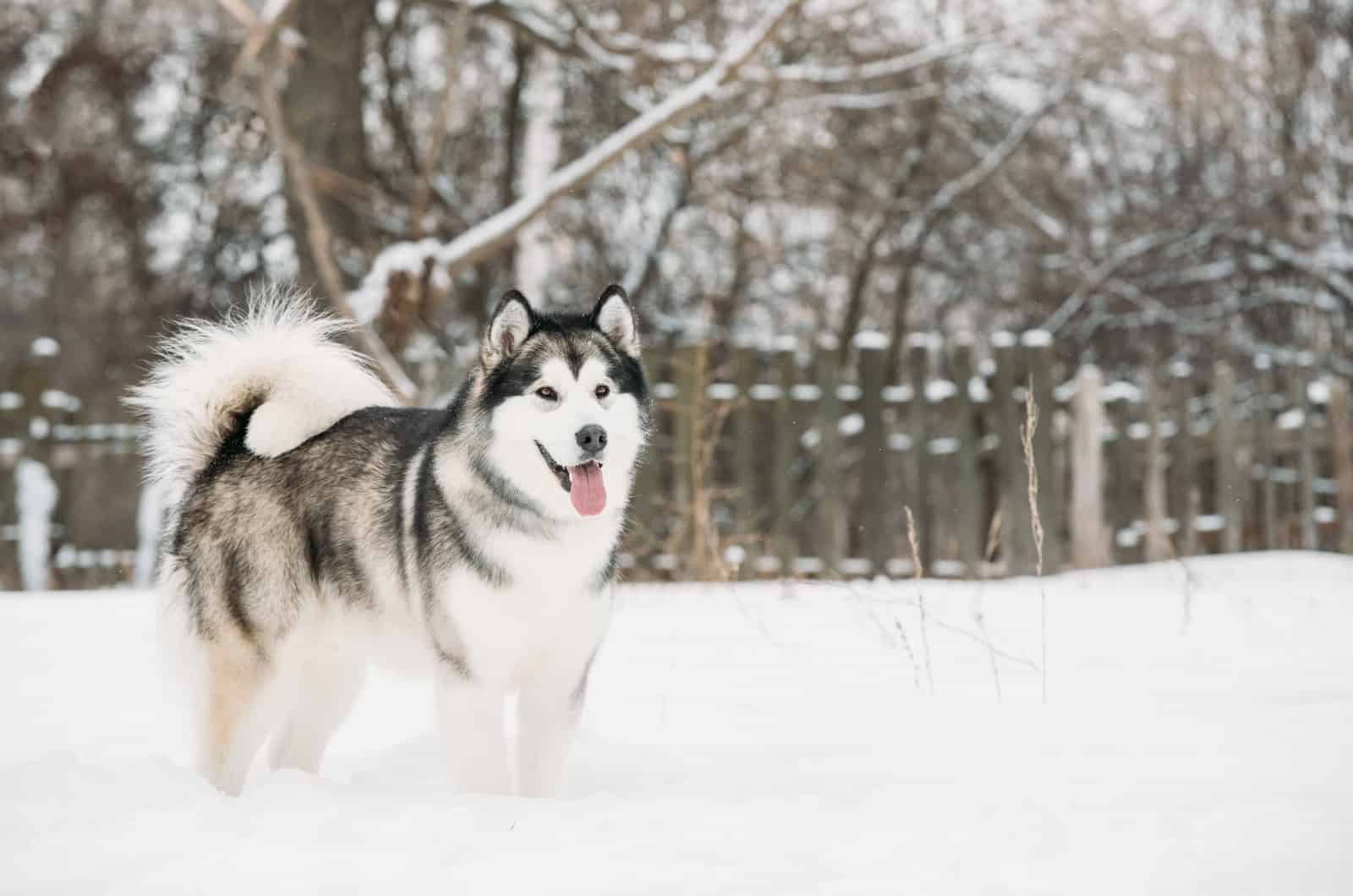
With the Alaskan Malamute feeding chart, you will be able to keep track of your canine’s weight and its overall development.
Diet is one of the most important factors for the healthy development of every canine, including Alaskan Malamutes.
Healthy food will keep your pup in great shape, and it will also prevent some serious health issues that might appear in these canines.
Unfortunately, feeding our furry buddies human foods can have a negative impact, as it comes with serious risks for their well-being.
Therefore, before you give in to those sweet puppy eyes, you should first check whether your Malamute should eat the same meal as you.
READ MORE:
Top 7 Reputable Alaskan Malamute Breeders In The U.S.
